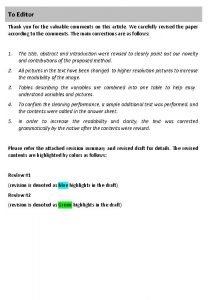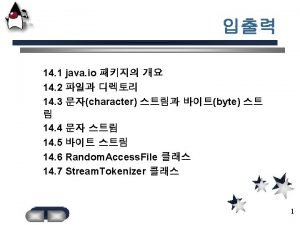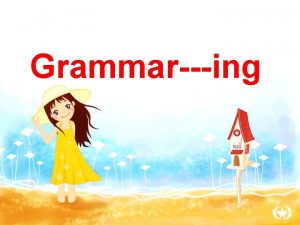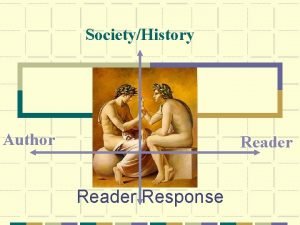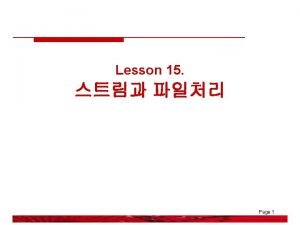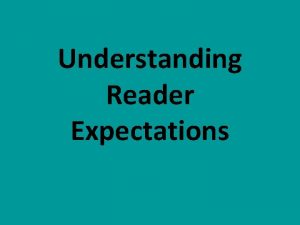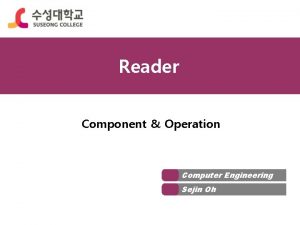Comments Comments are for the reader not the
















































































- Slides: 80


Comments • Comments are for the reader, not the compiler • Two types: − Single line // This is a C++ program. It prints the sentence: // Welcome to C++ Programming. − Multiple line /* You can include comments that can print several lines. */ C++ Programming: From Problem Analysis to Program Design, Fourth Edition ﺃﺴﺘﺎﺫ ﺍﻟﻤﺎﺩﺓ ﻧﺸﺄﺖ ﺍﻟﺮﻓﺎﻋﻲ 2

Reserved Words (Keywords) • Reserved words, keywords, or word symbols − Include: • int • float • double • char • const • void • return C++ Programming: From Problem Analysis to Program Design, Fourth Edition ﺃﺴﺘﺎﺫ ﺍﻟﻤﺎﺩﺓ ﻧﺸﺄﺖ ﺍﻟﺮﻓﺎﻋﻲ 3

Identifiers • Consist of letters, digits, and the underscore character (_) • Must begin with a letter or underscore • C++ is case sensitive − NUMBER is not the same as number C++ Programming: From Problem Analysis to Program Design, Fourth Edition ﺃﺴﺘﺎﺫ ﺍﻟﻤﺎﺩﺓ ﻧﺸﺄﺖ ﺍﻟﺮﻓﺎﻋﻲ 4

Identifiers (continued) • The following are legal identifiers in C++: − first − conversion − pay. Rate C++ Programming: From Problem Analysis to Program Design, Fourth Edition ﺃﺴﺘﺎﺫ ﺍﻟﻤﺎﺩﺓ ﻧﺸﺄﺖ ﺍﻟﺮﻓﺎﻋﻲ 5

Whitespaces • Every C++ program contains whitespaces − Include blanks, tabs, and newline characters • Used to separate special symbols • Proper utilization of whitespaces is important − Can be used to make the program readable C++ Programming: From Problem Analysis to Program Design, Fourth Edition ﺃﺴﺘﺎﺫ ﺍﻟﻤﺎﺩﺓ ﻧﺸﺄﺖ ﺍﻟﺮﻓﺎﻋﻲ 6

Data Types • Data type: set of values together with a set of operations • C++ data types fall into three categories: C++ Programming: From Problem Analysis to Program Design, Fourth Edition ﺃﺴﺘﺎﺫ ﺍﻟﻤﺎﺩﺓ ﻧﺸﺄﺖ ﺍﻟﺮﻓﺎﻋﻲ 7

Simple Data Types • Three categories of simple data − Integral: integers (numbers without a decimal) − Floating-point: decimal numbers − Enumeration type: user-defined data type C++ Programming: From Problem Analysis to Program Design, Fourth Edition ﺃﺴﺘﺎﺫ ﺍﻟﻤﺎﺩﺓ ﻧﺸﺄﺖ ﺍﻟﺮﻓﺎﻋﻲ 8

Simple Data Types (continued) • Integral data types are further classified into nine categories: C++ Programming: From Problem Analysis to Program Design, Fourth Edition ﺃﺴﺘﺎﺫ ﺍﻟﻤﺎﺩﺓ ﻧﺸﺄﺖ ﺍﻟﺮﻓﺎﻋﻲ 9

Simple Data Types (continued) • Different compilers may allow different ranges of values C++ Programming: From Problem Analysis to Program Design, Fourth Edition ﺃﺴﺘﺎﺫ ﺍﻟﻤﺎﺩﺓ ﻧﺸﺄﺖ ﺍﻟﺮﻓﺎﻋﻲ 10

int Data Type • Examples: -6728 0 78 +763 • Positive integers do not need a + sign • No commas are used within an integer − Commas are used for separating items in a list C++ Programming: From Problem Analysis to Program Design, Fourth Edition ﺃﺴﺘﺎﺫ ﺍﻟﻤﺎﺩﺓ ﻧﺸﺄﺖ ﺍﻟﺮﻓﺎﻋﻲ 11

bool Data Type • bool type − Two values: true and false C++ Programming: From Problem Analysis to Program Design, Fourth Edition ﺃﺴﺘﺎﺫ ﺍﻟﻤﺎﺩﺓ ﻧﺸﺄﺖ ﺍﻟﺮﻓﺎﻋﻲ 12

char Data Type • The smallest integral data type • Used for characters: letters, digits, and special symbols • Each character is enclosed in single quotes − 'A', 'a', '0', '*', '+', '$', '&' • A blank space is a character and is written ' ', with a space left between the single quotes C++ Programming: From Problem Analysis to Program Design, Fourth Edition ﺃﺴﺘﺎﺫ ﺍﻟﻤﺎﺩﺓ ﻧﺸﺄﺖ ﺍﻟﺮﻓﺎﻋﻲ 13

Floating-Point Data Types • C++ uses scientific notation to represent real numbers (floating-point notation) C++ Programming: From Problem Analysis to Program Design, Fourth Edition ﺃﺴﺘﺎﺫ ﺍﻟﻤﺎﺩﺓ ﻧﺸﺄﺖ ﺍﻟﺮﻓﺎﻋﻲ 14

Floating-Point Data Types (continued) − float: represents any real number • Range: -3. 4 E+38 to 3. 4 E+38 (four bytes) − double: represents any real number • Range: -1. 7 E+308 to 1. 7 E+308 (eight bytes) C++ Programming: From Problem Analysis to Program Design, Fourth Edition ﺃﺴﺘﺎﺫ ﺍﻟﻤﺎﺩﺓ ﻧﺸﺄﺖ ﺍﻟﺮﻓﺎﻋﻲ 15

Floating-Point Data Types (continued) • Maximum number of significant digits (decimal places) for float values is 6 or 7 • Maximum number of significant digits for double is 15 C++ Programming: From Problem Analysis to Program Design, Fourth Edition ﺃﺴﺘﺎﺫ ﺍﻟﻤﺎﺩﺓ ﻧﺸﺄﺖ ﺍﻟﺮﻓﺎﻋﻲ 16

Arithmetic Operators and Operator Precedence • C++ arithmetic operators: − + addition − - subtraction − * multiplication − / division − % modulus operator • +, -, *, and / can be used with integral and floating-point data types C++ Programming: From Problem Analysis to Program Design, Fourth Edition ﺃﺴﺘﺎﺫ ﺍﻟﻤﺎﺩﺓ ﻧﺸﺄﺖ ﺍﻟﺮﻓﺎﻋﻲ 17

Order of Precedence • All operations inside of () are evaluated first • *, /, and % are at the same level of precedence and are evaluated next • + and – have the same level of precedence and are evaluated last • When operators are on the same level − Performed from left to right • 3 * 7 - 6 + 2 * 5 / 4 + 6 means (((3 * 7) – 6) + ((2 * 5) / 4 )) + 6 C++ Programming: From Problem Analysis to Program Design, Fourth Edition ﺃﺴﺘﺎﺫ ﺍﻟﻤﺎﺩﺓ ﻧﺸﺄﺖ ﺍﻟﺮﻓﺎﻋﻲ 18

Expressions • If all operands are integers − Expression is called an integral expression • Yields an integral result • Example: 2 + 3 * 5 • If all operands are floating-point − Expression is called a floating-point expression • Yields a floating-point result • Example: 12. 8 * 17. 5 - 34. 50 C++ Programming: From Problem Analysis to Program Design, Fourth Edition ﺃﺴﺘﺎﺫ ﺍﻟﻤﺎﺩﺓ ﻧﺸﺄﺖ ﺍﻟﺮﻓﺎﻋﻲ 19

Mixed Expressions • Mixed expression: − Has operands of different data types − Contains integers and floating-point • Examples of mixed expressions: 2 + 3. 5 6 / 4 + 3. 9 5. 4 * 2 – 13. 6 + 18 / C++ Programming: From Problem Analysis to Program Design, Fourth Edition ﺃﺴﺘﺎﺫ ﺍﻟﻤﺎﺩﺓ ﻧﺸﺄﺖ ﺍﻟﺮﻓﺎﻋﻲ 2 20

Mixed Expressions (continued) • Evaluation rules: − If operator has same types of operands • Evaluated according to the type of the operands − If operator has both types of operands • Integer is changed to floating-point • Operator is evaluated • Result is floating-point − Entire expression is evaluated according to precedence rules C++ Programming: From Problem Analysis to Program Design, Fourth Edition ﺃﺴﺘﺎﺫ ﺍﻟﻤﺎﺩﺓ ﻧﺸﺄﺖ ﺍﻟﺮﻓﺎﻋﻲ 21

Type Conversion (Casting) • Implicit type coercion: when value of one type is automatically changed to another type • Cast operator: provides explicit type conversion static_cast<data. Type. Name>(expression) C++ Programming: From Problem Analysis to Program Design, Fourth Edition ﺃﺴﺘﺎﺫ ﺍﻟﻤﺎﺩﺓ ﻧﺸﺄﺖ ﺍﻟﺮﻓﺎﻋﻲ 22

Type Conversion (continued) C++ Programming: From Problem Analysis to Program Design, Fourth Edition ﺃﺴﺘﺎﺫ ﺍﻟﻤﺎﺩﺓ ﻧﺸﺄﺖ ﺍﻟﺮﻓﺎﻋﻲ 23

string Type • • Sequence of zero or more characters Enclosed in double quotation marks Null: a string with no characters Each character has relative position in string − Position of first character is 0 • Length of a string is number of characters in it − Example: length of "William Jacob" is 13 C++ Programming: From Problem Analysis to Program Design, Fourth Edition ﺃﺴﺘﺎﺫ ﺍﻟﻤﺎﺩﺓ ﻧﺸﺄﺖ ﺍﻟﺮﻓﺎﻋﻲ 24

Allocating Memory with Constants and Variables • Named constant: memory location whose content can’t change during execution • The syntax to declare a named constant is: • In C++, const is a reserved word C++ Programming: From Problem Analysis to Program Design, Fourth Edition ﺃﺴﺘﺎﺫ ﺍﻟﻤﺎﺩﺓ ﻧﺸﺄﺖ ﺍﻟﺮﻓﺎﻋﻲ 25

Allocating Memory with Constants and Variables (continued) • Variable: memory location whose content may change during execution • The syntax to declare a named constant is: C++ Programming: From Problem Analysis to Program Design, Fourth Edition ﺃﺴﺘﺎﺫ ﺍﻟﻤﺎﺩﺓ ﻧﺸﺄﺖ ﺍﻟﺮﻓﺎﻋﻲ 26

Putting Data into Variables • Ways to place data into a variable: − Use C++’s assignment statement − Use input (read) statements C++ Programming: From Problem Analysis to Program Design, Fourth Edition ﺃﺴﺘﺎﺫ ﺍﻟﻤﺎﺩﺓ ﻧﺸﺄﺖ ﺍﻟﺮﻓﺎﻋﻲ 27

Assignment Statement • The assignment statement takes the form: • Expression is evaluated and its value is assigned to the variable on the left side • In C++, = is called the assignment operator C++ Programming: From Problem Analysis to Program Design, Fourth Edition ﺃﺴﺘﺎﺫ ﺍﻟﻤﺎﺩﺓ ﻧﺸﺄﺖ ﺍﻟﺮﻓﺎﻋﻲ 28

Assignment Statement (continued) C++ Programming: From Problem Analysis to Program Design, Fourth Edition ﺃﺴﺘﺎﺫ ﺍﻟﻤﺎﺩﺓ ﻧﺸﺄﺖ ﺍﻟﺮﻓﺎﻋﻲ 29

Declaring & Initializing Variables • Variables can be initialized when declared: int first=13, second=10; char ch=' '; double x=12. 6; • All variables must be initialized before they are used − But not necessarily during declaration C++ Programming: From Problem Analysis to Program Design, Fourth Edition ﺃﺴﺘﺎﺫ ﺍﻟﻤﺎﺩﺓ ﻧﺸﺄﺖ ﺍﻟﺮﻓﺎﻋﻲ 30

Input (Read) Statement • cin is used with >> to gather input • The stream extraction operator is >> • For example, if miles is a double variable cin >> miles; − Causes computer to get a value of type double − Places it in the variable miles C++ Programming: From Problem Analysis to Program Design, Fourth Edition ﺃﺴﺘﺎﺫ ﺍﻟﻤﺎﺩﺓ ﻧﺸﺄﺖ ﺍﻟﺮﻓﺎﻋﻲ 31

Input (Read) Statement (continued) • Using more than one variable in cin allows more than one value to be read at a time • For example, if feet and inches are variables of type int, a statement such as: cin >> feet >> inches; − Inputs two integers from the keyboard − Places them in variables feet and inches respectively C++ Programming: From Problem Analysis to Program Design, Fourth Edition ﺃﺴﺘﺎﺫ ﺍﻟﻤﺎﺩﺓ ﻧﺸﺄﺖ ﺍﻟﺮﻓﺎﻋﻲ 32

Input (Read) Statement (continued) C++ Programming: From Problem Analysis to Program Design, Fourth Edition ﺃﺴﺘﺎﺫ ﺍﻟﻤﺎﺩﺓ ﻧﺸﺄﺖ ﺍﻟﺮﻓﺎﻋﻲ 33

Increment & Decrement Operators • Increment operator: increment variable by 1 − Pre-increment: ++variable − Post-increment: variable++ • Decrement operator: decrement variable by 1 − Pre-decrement: --variable − Post-decrement: variable— • What is the difference between the following? x = 5; y = ++x; x = 5; y = x++; C++ Programming: From Problem Analysis to Program Design, Fourth Edition ﺃﺴﺘﺎﺫ ﺍﻟﻤﺎﺩﺓ ﻧﺸﺄﺖ ﺍﻟﺮﻓﺎﻋﻲ 34

Output • The syntax of cout and << is: − Called an output statement • The stream insertion operator is << C++ Programming: From Problem Analysis to Program Design, Fourth Edition ﺃﺴﺘﺎﺫ ﺍﻟﻤﺎﺩﺓ ﻧﺸﺄﺖ ﺍﻟﺮﻓﺎﻋﻲ 35

Output (continued) • A manipulator is used to format the output − Example: endl causes insertion point to move to beginning of next line C++ Programming: From Problem Analysis to Program Design, Fourth Edition ﺃﺴﺘﺎﺫ ﺍﻟﻤﺎﺩﺓ ﻧﺸﺄﺖ ﺍﻟﺮﻓﺎﻋﻲ 36

Output (continued) • The new line character is 'n' − May appear anywhere in the string cout << "Hello there. "; cout << "My name is James. "; • Output: Hello there. My name is James. cout << "Hello there. n"; cout << "My name is James. "; • Output : Hello there. My name is James. C++ Programming: From Problem Analysis to Program Design, Fourth Edition ﺃﺴﺘﺎﺫ ﺍﻟﻤﺎﺩﺓ ﻧﺸﺄﺖ ﺍﻟﺮﻓﺎﻋﻲ 37

Output (continued) C++ Programming: From Problem Analysis to Program Design, Fourth Edition ﺃﺴﺘﺎﺫ ﺍﻟﻤﺎﺩﺓ ﻧﺸﺄﺖ ﺍﻟﺮﻓﺎﻋﻲ 38

Preprocessor Directives • Many functions and symbols needed to run a C++ program are provided as collection of libraries • Every library has a name and is referred to by a header file • All preprocessor commands begin with # • No semicolon at the end of these commands C++ Programming: From Problem Analysis to Program Design, Fourth Edition ﺃﺴﺘﺎﺫ ﺍﻟﻤﺎﺩﺓ ﻧﺸﺄﺖ ﺍﻟﺮﻓﺎﻋﻲ 39

Preprocessor Directives (continued) • Syntax to include a header file: • For example: #include <iostream> C++ Programming: From Problem Analysis to Program Design, Fourth Edition ﺃﺴﺘﺎﺫ ﺍﻟﻤﺎﺩﺓ ﻧﺸﺄﺖ ﺍﻟﺮﻓﺎﻋﻲ 40

Using the string Data Type in a Program • To use the string type, you need to access its definition from the header file string • Include the following preprocessor directive: #include <string> C++ Programming: From Problem Analysis to Program Design, Fourth Edition ﺃﺴﺘﺎﺫ ﺍﻟﻤﺎﺩﺓ ﻧﺸﺄﺖ ﺍﻟﺮﻓﺎﻋﻲ 41

Creating a C++ Program • C++ program has two parts: − Preprocessor directives − The program • Preprocessor directives and program statements constitute C++ source code (. cpp) • Compiler generates object code (. obj) • Executable code is produced and saved in a file with the file extension. exe C++ Programming: From Problem Analysis to Program Design, Fourth Edition ﺃﺴﺘﺎﺫ ﺍﻟﻤﺎﺩﺓ ﻧﺸﺄﺖ ﺍﻟﺮﻓﺎﻋﻲ 42

C++ Programming: From Problem Analysis to Program Design, Fourth Edition ﺃﺴﺘﺎﺫ ﺍﻟﻤﺎﺩﺓ ﻧﺸﺄﺖ ﺍﻟﺮﻓﺎﻋﻲ 43

Creating a C++ Program (continued) Sample Run: Line 9: first. Num = 18 Line 10: Enter an integer: 15 Line 13: second. Num = 15 Line 15: The new value of first. Num = 60 C++ Programming: From Problem Analysis to Program Design, Fourth Edition ﺃﺴﺘﺎﺫ ﺍﻟﻤﺎﺩﺓ ﻧﺸﺄﺖ ﺍﻟﺮﻓﺎﻋﻲ 44

Syntax • Errors in syntax are found in compilation int x; int y double z; //Line 1 //Line 2: error //Line 3 y = w + x; //Line 4: error C++ Programming: From Problem Analysis to Program Design, Fourth Edition ﺃﺴﺘﺎﺫ ﺍﻟﻤﺎﺩﺓ ﻧﺸﺄﺖ ﺍﻟﺮﻓﺎﻋﻲ 45

Form and Style • Consider two ways of declaring variables: − Method 1 int feet, inch; double x, y; − Method 2 int a, b; double x, y; • Both are correct; however, the second is hard to read C++ Programming: From Problem Analysis to Program Design, Fourth Edition ﺃﺴﺘﺎﺫ ﺍﻟﻤﺎﺩﺓ ﻧﺸﺄﺖ ﺍﻟﺮﻓﺎﻋﻲ 46

More on Assignment Statements • C++ has special assignment statements called compound assignments +=, -=, *=, /=, and %= • Example: x *= y; C++ Programming: From Problem Analysis to Program Design, Fourth Edition ﺃﺴﺘﺎﺫ ﺍﻟﻤﺎﺩﺓ ﻧﺸﺄﺖ ﺍﻟﺮﻓﺎﻋﻲ 47

C++ Programming: From Problem Analysis to Program Design, Fourth Edition ﺃﺴﺘﺎﺫ ﺍﻟﻤﺎﺩﺓ ﻧﺸﺄﺖ ﺍﻟﺮﻓﺎﻋﻲ 48

Programming Example: Sample Run Enter two integers, one for feet, one for inches: 15 7 The numbers you entered are 15 for feet and 7 for inches. The total number of inches = 187 The number of centimeters = 474. 98 C++ Programming: From Problem Analysis to Program Design, Fourth Edition ﺃﺴﺘﺎﺫ ﺍﻟﻤﺎﺩﺓ ﻧﺸﺄﺖ ﺍﻟﺮﻓﺎﻋﻲ 49

Input/Output C++ Programming: From Problem Analysis to Program Design, Fourth Edition ﺃﺴﺘﺎﺫ ﺍﻟﻤﺎﺩﺓ ﻧﺸﺄﺖ ﺍﻟﺮﻓﺎﻋﻲ 50

I/O Streams and Standard I/O Devices (continued) • Use iostream header file to extract (receive) data from keyboard and send output to the screen − Contains definitions of two data types: • istream - input stream • ostream - output stream − Has two variables: • cin - stands for common input • cout - stands for common output C++ Programming: From Problem Analysis to Program Design, Fourth Edition ﺃﺴﺘﺎﺫ ﺍﻟﻤﺎﺩﺓ ﻧﺸﺄﺖ ﺍﻟﺮﻓﺎﻋﻲ 51

cin and the Extraction Operator >> • The syntax of an input statement using cin and the extraction operator >> is: C++ Programming: From Problem Analysis to Program Design, Fourth Edition ﺃﺴﺘﺎﺫ ﺍﻟﻤﺎﺩﺓ ﻧﺸﺄﺖ ﺍﻟﺮﻓﺎﻋﻲ 52

cin and the Extraction Operator >> (continued) C++ Programming: From Problem Analysis to Program Design, Fourth Edition ﺃﺴﺘﺎﺫ ﺍﻟﻤﺎﺩﺓ ﻧﺸﺄﺖ ﺍﻟﺮﻓﺎﻋﻲ 53

C++ Programming: From Problem Analysis to Program Design, Fourth Edition ﺃﺴﺘﺎﺫ ﺍﻟﻤﺎﺩﺓ ﻧﺸﺄﺖ ﺍﻟﺮﻓﺎﻋﻲ 54

Using Predefined Functions in a Program • To use a predefined function, you need the name of the appropriate header file − You also need to know: • Function name • Number of parameters required • Type of each parameter • What the function is going to do C++ Programming: From Problem Analysis to Program Design, Fourth Edition ﺃﺴﺘﺎﺫ ﺍﻟﻤﺎﺩﺓ ﻧﺸﺄﺖ ﺍﻟﺮﻓﺎﻋﻲ 55

Using Predefined Functions in a Program (continued) • To use pow (power), include cmath − Two numeric parameters − Syntax: pow(x, y) = xy • x and y are the arguments or parameters − In pow(2, 3), the parameters are 2 and 3 C++ Programming: From Problem Analysis to Program Design, Fourth Edition ﺃﺴﺘﺎﺫ ﺍﻟﻤﺎﺩﺓ ﻧﺸﺄﺖ ﺍﻟﺮﻓﺎﻋﻲ 56

C++ Programming: From Problem Analysis to Program Design, Fourth Edition ﺃﺴﺘﺎﺫ ﺍﻟﻤﺎﺩﺓ ﻧﺸﺄﺖ ﺍﻟﺮﻓﺎﻋﻲ 57

Using Predefined Functions in a Program (continued) Sample Run: Line Line 1: 4: 5: 7: 9: 2 to the power of 6 = 64 12. 5 to the power of 3 = 1953. 13 Square root of 24 = 4. 89898 u = 181. 019 Length of str = 20 C++ Programming: From Problem Analysis to Program Design, Fourth Edition ﺃﺴﺘﺎﺫ ﺍﻟﻤﺎﺩﺓ ﻧﺸﺄﺖ ﺍﻟﺮﻓﺎﻋﻲ 58

Output and Formatting Output • Syntax of cout when used with << C++ Programming: From Problem Analysis to Program Design, Fourth Edition ﺃﺴﺘﺎﺫ ﺍﻟﻤﺎﺩﺓ ﻧﺸﺄﺖ ﺍﻟﺮﻓﺎﻋﻲ 59

Control Structures I (Selection) C++ Programming: From Problem Analysis to Program Design, Fourth Edition ﺃﺴﺘﺎﺫ ﺍﻟﻤﺎﺩﺓ ﻧﺸﺄﺖ ﺍﻟﺮﻓﺎﻋﻲ 60

Control Structures • A computer can proceed: − In sequence − Selectively (branch) - making a choice − Repetitively - looping • Some statements are executed only if certain conditions are met • A condition is met if it evaluates to true C++ Programming: From Problem Analysis to Program Design, Fourth Edition ﺃﺴﺘﺎﺫ ﺍﻟﻤﺎﺩﺓ ﻧﺸﺄﺖ ﺍﻟﺮﻓﺎﻋﻲ 61

Control Structures (continued) C++ Programming: From Problem Analysis to Program Design, Fourth Edition ﺃﺴﺘﺎﺫ ﺍﻟﻤﺎﺩﺓ ﻧﺸﺄﺖ ﺍﻟﺮﻓﺎﻋﻲ 62

Relational Operators (continued) C++ Programming: From Problem Analysis to Program Design, Fourth Edition ﺃﺴﺘﺎﺫ ﺍﻟﻤﺎﺩﺓ ﻧﺸﺄﺖ ﺍﻟﺮﻓﺎﻋﻲ 63

Relational Operators and Simple Data Types − 8 < 15 evaluates to true − 6 != 6 evaluates to false − 2. 5 > 5. 8 evaluates to false − 5. 9 <= 7. 5 evaluates to true C++ Programming: From Problem Analysis to Program Design, Fourth Edition ﺃﺴﺘﺎﺫ ﺍﻟﻤﺎﺩﺓ ﻧﺸﺄﺖ ﺍﻟﺮﻓﺎﻋﻲ 64

Comparing Floating-Point Numbers for Equality • Comparison of floating-point numbers for equality may not behave as you would expect − Example: • 1. 0 == 3. 0/7. 0 + 2. 0/7. 0 evaluates to false • Why? 3. 0/7. 0 + 2. 0/7. 0 = 0. 9999999989 C++ Programming: From Problem Analysis to Program Design, Fourth Edition ﺃﺴﺘﺎﺫ ﺍﻟﻤﺎﺩﺓ ﻧﺸﺄﺖ ﺍﻟﺮﻓﺎﻋﻲ 65

Comparing Characters C++ Programming: From Problem Analysis to Program Design, Fourth Edition ﺃﺴﺘﺎﺫ ﺍﻟﻤﺎﺩﺓ ﻧﺸﺄﺖ ﺍﻟﺮﻓﺎﻋﻲ 66

Relational Operators and the string Type • Relational operators can be applied to strings • Strings are compared character by character, starting with the first character • Comparison continues until either a mismatch is found or all characters are found equal • If two strings of different lengths are compared and the comparison is equal to the last character of the shorter string − The shorter string is less than the larger string C++ Programming: From Problem Analysis to Program Design, Fourth Edition ﺃﺴﺘﺎﺫ ﺍﻟﻤﺎﺩﺓ ﻧﺸﺄﺖ ﺍﻟﺮﻓﺎﻋﻲ 67

Relational Operators and the string Type (continued) • Suppose we have the following declarations: string string str 1 str 2 str 3 str 4 = = = "Hello"; "Hi"; "Air"; "Bill"; "Big"; C++ Programming: From Problem Analysis to Program Design, Fourth Edition ﺃﺴﺘﺎﺫ ﺍﻟﻤﺎﺩﺓ ﻧﺸﺄﺖ ﺍﻟﺮﻓﺎﻋﻲ 68

Relational Operators and the string Type (continued) C++ Programming: From Problem Analysis to Program Design, Fourth Edition ﺃﺴﺘﺎﺫ ﺍﻟﻤﺎﺩﺓ ﻧﺸﺄﺖ ﺍﻟﺮﻓﺎﻋﻲ 69

Relational Operators and the string Type (continued) C++ Programming: From Problem Analysis to Program Design, Fourth Edition ﺃﺴﺘﺎﺫ ﺍﻟﻤﺎﺩﺓ ﻧﺸﺄﺖ ﺍﻟﺮﻓﺎﻋﻲ 70

Relational Operators and the string Type (continued) C++ Programming: From Problem Analysis to Program Design, Fourth Edition ﺃﺴﺘﺎﺫ ﺍﻟﻤﺎﺩﺓ ﻧﺸﺄﺖ ﺍﻟﺮﻓﺎﻋﻲ 71

Logical (Boolean) Operators and Logical Expressions • Logical (Boolean) operators enable you to combine logical expressions unary binary C++ Programming: From Problem Analysis to Program Design, Fourth Edition ﺃﺴﺘﺎﺫ ﺍﻟﻤﺎﺩﺓ ﻧﺸﺄﺖ ﺍﻟﺮﻓﺎﻋﻲ 72

Logical (Boolean) Operators and Logical Expressions (continued) C++ Programming: From Problem Analysis to Program Design, Fourth Edition ﺃﺴﺘﺎﺫ ﺍﻟﻤﺎﺩﺓ ﻧﺸﺄﺖ ﺍﻟﺮﻓﺎﻋﻲ 73

C++ Programming: From Problem Analysis to Program Design, Fourth Edition ﺃﺴﺘﺎﺫ ﺍﻟﻤﺎﺩﺓ ﻧﺸﺄﺖ ﺍﻟﺮﻓﺎﻋﻲ 74

C++ Programming: From Problem Analysis to Program Design, Fourth Edition ﺃﺴﺘﺎﺫ ﺍﻟﻤﺎﺩﺓ ﻧﺸﺄﺖ ﺍﻟﺮﻓﺎﻋﻲ 75

Order of Precedence • Relational and logical operators are evaluated from left to right • Parentheses can override precedence C++ Programming: From Problem Analysis to Program Design, Fourth Edition ﺃﺴﺘﺎﺫ ﺍﻟﻤﺎﺩﺓ ﻧﺸﺄﺖ ﺍﻟﺮﻓﺎﻋﻲ 76

Order of Precedence (continued) C++ Programming: From Problem Analysis to Program Design, Fourth Edition ﺃﺴﺘﺎﺫ ﺍﻟﻤﺎﺩﺓ ﻧﺸﺄﺖ ﺍﻟﺮﻓﺎﻋﻲ 77

Order of Precedence (continued) C++ Programming: From Problem Analysis to Program Design, Fourth Edition ﺃﺴﺘﺎﺫ ﺍﻟﻤﺎﺩﺓ ﻧﺸﺄﺖ ﺍﻟﺮﻓﺎﻋﻲ 78

Order of Precedence (continued) C++ Programming: From Problem Analysis to Program Design, Fourth Edition ﺃﺴﺘﺎﺫ ﺍﻟﻤﺎﺩﺓ ﻧﺸﺄﺖ ﺍﻟﺮﻓﺎﻋﻲ 79

Order of Precedence (continued) C++ Programming: From Problem Analysis to Program Design, Fourth Edition ﺃﺴﺘﺎﺫ ﺍﻟﻤﺎﺩﺓ ﻧﺸﺄﺖ ﺍﻟﺮﻓﺎﻋﻲ 80
 Insidan region jh
Insidan region jh Sadlier unit 1 level d synonyms
Sadlier unit 1 level d synonyms Adressändring ideell förening
Adressändring ideell förening Verktyg för automatisering av utbetalningar
Verktyg för automatisering av utbetalningar Texter för hinduer tantra
Texter för hinduer tantra Cks
Cks Inköpsprocessen steg för steg
Inköpsprocessen steg för steg Kolposkopi, px
Kolposkopi, px Bo bergman jag fryser om dina händer
Bo bergman jag fryser om dina händer Strategi för svensk viltförvaltning
Strategi för svensk viltförvaltning Varians formel
Varians formel Datorkunskap för nybörjare
Datorkunskap för nybörjare Tack för att ni har lyssnat
Tack för att ni har lyssnat Läkarutlåtande för livränta
Läkarutlåtande för livränta Klassificeringsstruktur för kommunala verksamheter
Klassificeringsstruktur för kommunala verksamheter Vad står k.r.å.k.a.n för
Vad står k.r.å.k.a.n för Påbyggnader för flakfordon
Påbyggnader för flakfordon Tack för att ni lyssnade
Tack för att ni lyssnade Egg för emanuel
Egg för emanuel Tack för att ni har lyssnat
Tack för att ni har lyssnat Personlig tidbok fylla i
Personlig tidbok fylla i Rutin för avvikelsehantering
Rutin för avvikelsehantering Var finns arvsanlagen
Var finns arvsanlagen Verifikationsplan
Verifikationsplan Rbk fuktmätning
Rbk fuktmätning Kontinuitetshantering i praktiken
Kontinuitetshantering i praktiken Myndigheten för delaktighet
Myndigheten för delaktighet Presentera för publik crossboss
Presentera för publik crossboss Var 1721 för stormaktssverige
Var 1721 för stormaktssverige Tobinskatten för och nackdelar
Tobinskatten för och nackdelar Tack för att ni har lyssnat
Tack för att ni har lyssnat Boverket ka
Boverket ka Referatmarkeringar
Referatmarkeringar Kraftledning karttecken
Kraftledning karttecken Mjälthilus
Mjälthilus Shingelfrisyren
Shingelfrisyren Arkimedes princip formel
Arkimedes princip formel Större än
Större än Elektronik för barn
Elektronik för barn Borra hål för knoppar
Borra hål för knoppar Mat för idrottare
Mat för idrottare A gastrica
A gastrica Smärtskolan kunskap för livet
Smärtskolan kunskap för livet Bris för vuxna
Bris för vuxna Jiddisch
Jiddisch Novell typiska drag
Novell typiska drag Frgar
Frgar Delegerande ledarstil
Delegerande ledarstil Humanitr
Humanitr Rita perspektiv
Rita perspektiv Toppslätskivling dos
Toppslätskivling dos Redogör för vad psykologi är
Redogör för vad psykologi är Hur skriver man en tes
Hur skriver man en tes Skapa med geometriska former
Skapa med geometriska former Claes martinsson
Claes martinsson En lathund för arbete med kontinuitetshantering
En lathund för arbete med kontinuitetshantering Etik och ledarskap etisk kod för chefer
Etik och ledarskap etisk kod för chefer Svenskt ramverk för digital samverkan
Svenskt ramverk för digital samverkan Bunden form dikt
Bunden form dikt Vad kallas den mantel som bars av kvinnor i antikens rom
Vad kallas den mantel som bars av kvinnor i antikens rom Vilken grundregel finns det för tronföljden i sverige?
Vilken grundregel finns det för tronföljden i sverige? Densitet vatten
Densitet vatten Ministerstyre för och nackdelar
Ministerstyre för och nackdelar Jätte råtta
Jätte råtta Plats för toran ark
Plats för toran ark Tack för att ni lyssnade bild
Tack för att ni lyssnade bild Tillitsbaserad ledning
Tillitsbaserad ledning Nyckelkompetenser för livslångt lärande
Nyckelkompetenser för livslångt lärande Romarriket tidslinje
Romarriket tidslinje Vad är verksamhetsanalys
Vad är verksamhetsanalys Mästare lärling modell
Mästare lärling modell Borstål, egenskaper
Borstål, egenskaper Comments for chapter 13
Comments for chapter 13 Form tutor report comments
Form tutor report comments Thank you for valuable comments
Thank you for valuable comments How do you write a good comment?
How do you write a good comment? Uc application personal statement
Uc application personal statement Npqml sponsor comments examples
Npqml sponsor comments examples Pyp exhibition timeline
Pyp exhibition timeline Chapter 10 hunger games questions
Chapter 10 hunger games questions Collegial
Collegial










































































